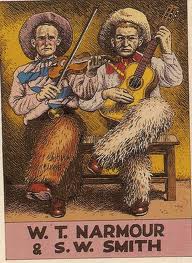Biography:Willie Narmour
WILLIE NARMOUR (1889-1961). William Thomas Narmour was born in Ackerman, Mississippi, in 1889 but moved with his family as a young boy to Carroll County in the central part of the state, where he lived the remainder of his life. His father was a fiddler and his first mentor. In 1927 Narmour was heard by an Okeh Records scout at Doc Bailey's 1927 Winona Fiddle Contest, and he and his playing partner, Shellie Smith (1895-1968) on guitar, were invited to record for the company. Their recordings proved popular (their "Carroll County Blues" was one of the best-selling records of 1929, according to Talking Machine World, a recording industry trade paper), particularly in the southwest and west, and even in Mexico, and they remained with Okeh records until the collapse of the company in the early 1930's. Thereafter, they signed with Victor Records, and in 1934 the duo re-recorded sixteen of their most popular sides and toured.
The Depression caused many of the 1920's and early 1930's old-time music artists to cease recording, but Narmour and Smith lasted longer than others. After 1934 Narmour went back to farming, driving a school bus and operating a garage in Avalon, while Smith became a school custodian. Smith did not play in public again, but Narmour continued to play locally.

The following appears on the roadside marker of the Mississippi Country Music Trail:
Narmour and Smith - Carrollton
Blending blues and old-time dance tunes, fiddler William T. Narmour (1889–1961) and guitarist Shellie W. Smith (1895–1968) became an influential duo with forty-eight recordings for Okeh and Bluebird records from 1928 to 1934 that often emphasized their home base–including “Carroll County Blues” and “Avalon Quick Step.” African-American bluesman Mississippi John Hurt, a nearby neighbor of Willie Narmour, often substituted for Smith on guitar when he was unavailable for appearances; it was Narmour who brought the legendary Hurt to Okeh Records’ attention. Carroll County natives “Willie” Thomas Narmour and “Shell” Smith were dirt farming friends who played music together from childhood. The duo became well known throughout the area by the 1920s for the sometimes hot, sometimes lazy fiddle and guitar breakdowns, waltzes, and rags they played at dances, county fairs and picnics. They made their most significant impression at fiddlers’ conventions in nearby Kosciusko and Winona. At the 1927 convention at Winona, they were spotted by the active area talent scout and record dealer, veterinarian Dr. A.M. “Doc” Bailey, who brought them to the attention of Okeh Records. They made their first records for Okeh in Memphis, in February 1928, including “Captain George, Has Your Money Come?” and “Who’s Been Giving You Corn?” At their second session, in Atlanta, less than a month later, they came up with the successful two-sided hit record that introduced their slow, infectious tunes “Carroll County Blues” and “Charleston,” which proved to be among the most lasting in Mississippi string bands’ repertoires ever after. Now established recording stars, Narmour & Smith were recruited to join such famed performers of the day as Fiddlin’ John Carson and Frank Hutchison on one of the label’s “Medicine Show” revue records. As early as 1924, African-American songster John Hurt, a long-time acquaintance of Shell Smith, was playing guitar with Willie Narmour at dances when Shell was unavailable; Narmour arranged an audition for him with Okeh recording director Tommy Rockwell, resulting in Mississippi John Hurt’s first recordings. Homebodies at heart, neither member of the duo was inclined to tour, but they traveled as far as New York and San Antonio to record 32 sides for Okeh between 1928 and June 1930, by which time the entire recording industry was in a major Depression-era slump. Their recording career had a final coda, when they recorded 16 sides for the Bluebird label in July 1934, all remakes of tunes they’d recorded earlier. Narmour, married to Velma Carroll, farmed, drove a school bus and ran a mechanic’s garage in Avalon. Smith, married to Lillian Kirby, would farm and later work as custodian at the rural Valley High School. They continued to perform locally into the 1950s. While their instrumentals have lasted, and Mississippi John Hurt found global attention in the folk revival of the 1960s, Narmour and Smith were not able to benefit from the renewed interest in music of their time and this place. A massive stroke took Narmour’s life in March 1961. Smith was interviewed by revival researchers before he died in April 1968.
